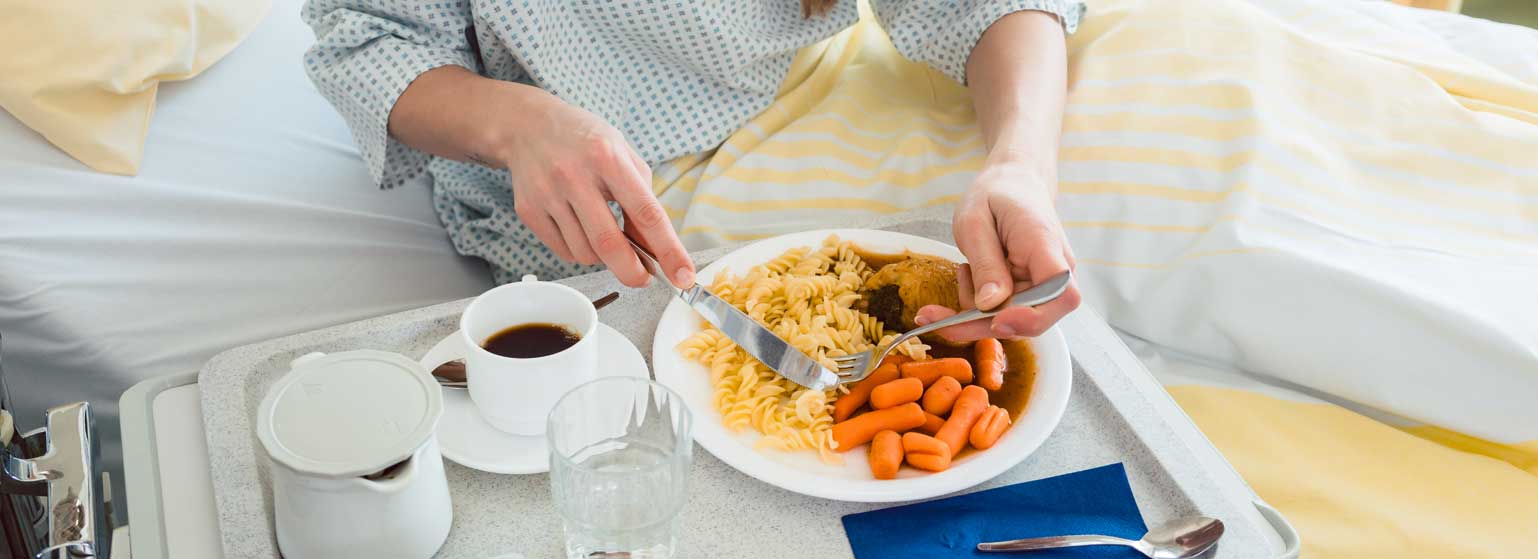Food Waste Dryers for Hospitals

Hospitals are among the largest producers of food waste. In Scotland, Northern Ireland and Wales it is illegal to use macerators or waste-to-water machines to pump food waste into the drain system. The food waste dryer is therefore an ideal solution. England has different food waste disposal rules but putting food waste into drains will likely also soon be illegal.
The dryer is already in use in NHS hospitals. It reduces the wet food waste into a dry, sterile powder, 15 -20% of its original weight and volume. The number of bins is reduced by 80%, lowering disposal costs and minimizing manual handling risks moving heavy wheelie bins.
Drying food waste overnight is the hygienic answer to food waste disposal, particularly important in a hospital environment. It avoids drain blockages and eliminates risks from vermin from wet food waste rotting in bins and compactors.
How Much Food Waste Does a Hospital Produce?
The answer depends on the type of hospital and whether food is prepared on site. Our experience is that acute hospitals with their own preparation kitchens create the most food waste per patient at between 140kg to 220kg per bed, per annum. Where preparation is done off-site via ‘cook-freeze’ or ‘regen’ processes, the weight of food waste can be 60% of this weight. This is because preparation waste is located elsewhere in the supply chain.
Our advice to all catering managers and estates departments that currently use wheelie bins, macerators or waste-to-water systems, is to weigh food waste each day for one week before it is disposed. Our experience is that guessing the overall weight based on the number of bins will not be accurate enough. You will need to know the peak days in the week to choose the right model. Typically, this produces much higher weights than expected.
Which Food Waste Dryer Is Right For My Hospital?
Knowing the weight of food waste produced daily is key to deciding which model of food waste dryer is right for your operation. For example, the ES150 has a maximum capacity of 100kg per day. If your weight is close to this or peaks above this the you should consider a larger unit or splitting the volume across two smaller units.
Another consideration is the kitchen operational hours. The drying cycle is typically 13-16 hours depending on how full it was at the start of the cycle. Most hospitals want to load new food waste as it is produced so having two smaller units will allow one unit to be drying, while the other is loaded. For example, a kitchen that produces 150kg per day could choose one ES300 unit (maximum load 200kg). If the machine is loaded and switched on at 7pm, it would be ready to empty (lasting approximately 15 minutes) at approximately 10am.
Alternatively, they could choose two ES150 models (100kg maximum each) and use one unit for breakfast and lunch waste, starting the cycle at 2pm. This cycle would finish around 5am, ready to be emptied and be available for loading as soon as the kitchen opens. The other unit could take the afternoon and dinner waste, being switched on at say 9pm. This cycle would finish around 12 noon, ready to receive the afternoon waste.
There are six models of machine with capacities from 20kg per day up to 350kg per day.
A Word on Alternative Technologies Available
Most hospitals in England are using macerators. This technology is illegal elsewhere in the UK and becoming unacceptable. The alternative choice therefore lies between waste-to-water units, grey water slurry tanks, wheelie bins or drying the food waste.
Waste-to-water units use enzymes and a flow of hot water to liquidize food waste. They are banned in NI, Scotland and Wales as they are deemed still to be putting food waste into the drains. They also use large volumes of water, up to 600L per hour in some cases.
Grey water systems require the installation of pipework from the macerator to a holding tank outside the building. No food waste goes into the drain but the installation is expensive, typically well in excess of £100,000. The tank must be emptied regularly, often once a week at high cost using a special tanker vehicle. The slurry goes to anaerobic digestion and therefore is recycled but the infrastructure and ongoing tank-emptying costs are high.
Wheelie bins are likely the most popular option and are frequently used as a back up when macerators break down. Their main drawback is the requirement to empty them very frequently, maybe even daily in order to minimize vermin risks. They are also very heavy when full, creating manual handling risks. Charges are based on an average weight, whether or not the bin is full and since food waste is 80% water, you are paying to have water removed. A food waste dryer removes that water so the weight is only the solid element, thereby reducing the cost significantly.
For More Information
We have extensive experience dealing with food waste in hospitals and can come to your hospital to discuss your problems and objectives, and how our Eco-Smart Food Waste Dryer can meet and solve them. Check out the range of models on our product page.

Download Your Guide To The New Food Waste Disposal Rules In England
The Problems of Traditional Food Waste Disposal Methods
The Immediate Benefits of the Eco-Smart Food Waste Dryer
How the Eco-Smart Food Waste Dryer Works
Choosing the Right Model for Your Organisation
What Happens to the Dried Powder?
Installation and Commissioning
Maintenance and Servicing
